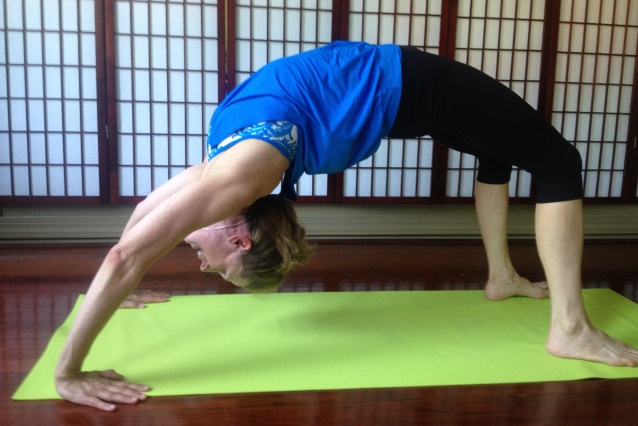A student recently made a comment about the picture of me in Dwi Pada Viparita Dandasana. They said that they would love to be able to do the pose but they didn’t think their low back could take that much bending.
Dwi Pada Viparita Dandasana (Two Legged Inverted Staff Pose)
Back bending is so about so much more than bending at the lumbar spine. It requires flexibility in the rib cage, shoulders and hips. The lumbar and cervical areas are the most flexible parts of the spine, but you can create problems by moving too much in those places.
Because of that comment, I decided that I will change how I teach one of my classes at Cornerstone. I will continue to teach my Monday class using a rotation of postures each week, but I will dedicate my Friday class to “Learning and Loving Backbends.” (At least for the month of February.) Let me know what you think.
I remember several years ago someone came up to me asking about improving their wrist flexibility for back bends. I asked them if they could do plank without pain in their wrist and they said yes. I knew immediately that they didn’t have a wrist problem, they had a shoulder and hip problem. In yoga, the site of the pain is usually not the cause of the pain.
Here’s a picture of me doing a picture where I am simulating what the shape looks like when your wrists hurt in wheel.
Our wrists bend approximately 85 degrees. In this picture, I am forcing my wrists to bend at a much more acute angle, which causes pain and suffering.
Wheel with my wrists bent at an acute angle. Ouch!
If you look at this next picture of me doing wheel, you can see that my forearms are more perpendicular to the floor. My wrists are at a much more comfortable angle so they don’t hurt. But notice how much more vertical my arms and chest are. Those are the body parts that need to open to be able to do Wheel.
A more vertical Wheel.
This is why I like to practice Wheel at the wall. It gives me a direction to move my chest. I know if I can get my chest to the wall, then I am vertical. Then I know I am ready to lower my forearms to the floor to try for Dwi Pada.
Urdhva Dhanurasana with my chest to the wall.
However!
Let’s not forget the lower body. In order to be able to do a backbend with the body evenly extended, we also have to open the hips. We need to be able to extend the hips and keep the legs in neutral rotation and not turning out. It the legs turn out during back bends it can cause pinching and pain. We can practice this by doing Bridge Pose (Setu Bandha) over a block, Camel (Ustrasana) with our pubic bone at the wall or held to a chair and Reclined Hero Pose (Supta Virasana) which opens the quads and psoas.
Camel with the pubic bone at the wall.
Setu Bandha over a block.
Supta Virasana
This all takes time and doesn’t happen overnight, which is why I thought I would dedicate Fridays to backbending. If one student is interested in learning to back bend with ease, maybe others would be as well. And opening the hips and shoulders can benefit everybody!
Interested in joining me?
Backbends are energizing postures that undo the habits of bad posture and counter the effects hunching our shoulders up around our ears when we are cold. This is such a great time of year to start them!








